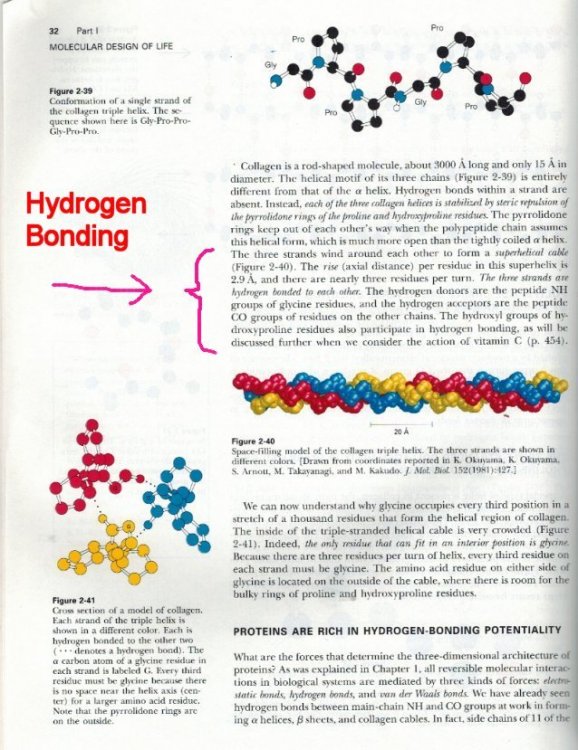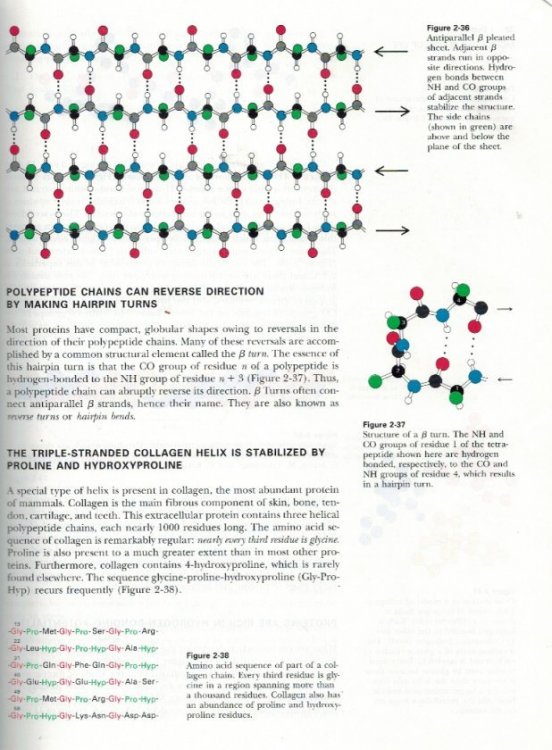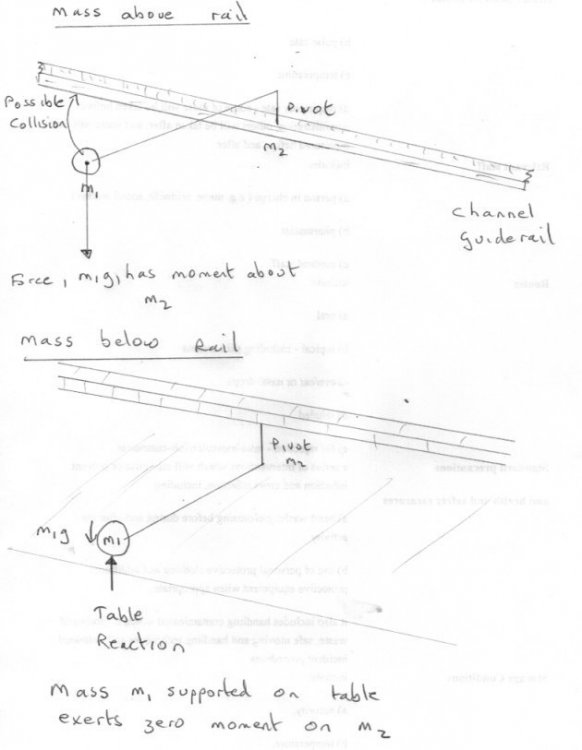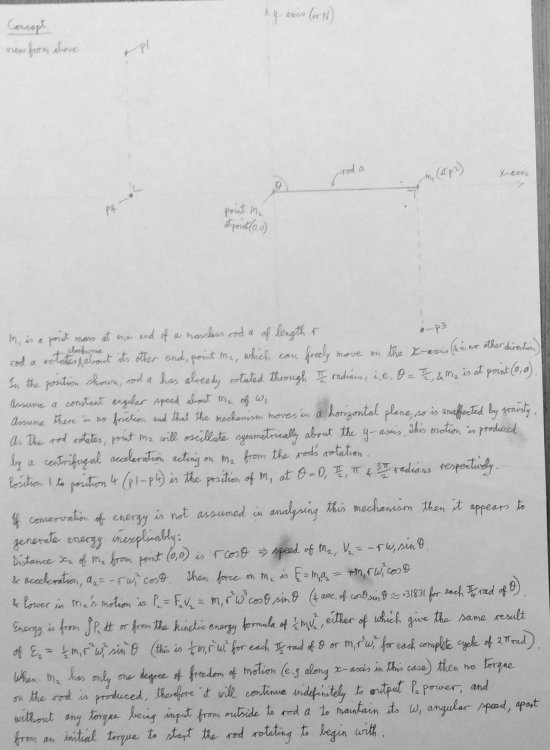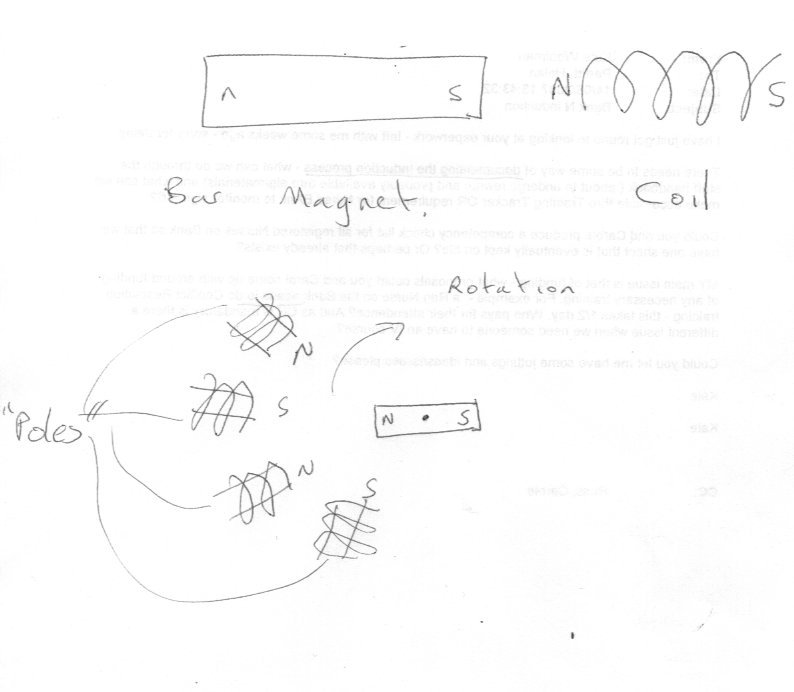-
Posts
18313 -
Joined
-
Last visited
-
Days Won
104
Content Type
Profiles
Forums
Events
Everything posted by studiot
-
As I implied it can only be true if it doesn't break Newton's Laws. That means motion not in a straight line only occurs when a real force acts. So this has not answered my point at all. A further question. You say there is tension in the rod. How is this possible? Tension requires two opposing forces. So calculating the force external and internal to the rod is the key to this. The analysis of the scotch yoke is similar, which is why I suggested it. A pity you rejected it. Of course in the real world this includes friction, which is why the yoke requires constant drive. Engineers use the "instantaneous centre concept" to analyse the motions of all the moving bits of machinery in a machine.
-

How to do this question regarding competitive enzyme?
studiot replied to JonasAbrahamWee's topic in Homework Help
Double thread posted moderator please combine. -
I think your difficulty in analysing the motion stems from jumping between different frames of reference. m2 is only momentarily located at the origin of a rest frame (in this case the guide rail) The rest of the time m2 is located elsewhere. So you cannot use it as the fixed centre of a rotating vector to resolve into sin and cos components.
-
So you are saying that your postulate is that if the light source and the observer are one and the same, there is an apparent change in the zero difference in position between source and observer? This must lead to my equation for what observer 1 sees to be incorrect. So what is your version of the 'correct' equation and how may it be tested. I ask for tests because, to my knowledge, no one has ever observed this effect. I am still waiting for a mathematical description of the light front surface for observer 2. Why are you so hung up on wave motion or the ether ? Einstein did not use any particular form of motion in SRT. Have you read the paper? In it he specifically refutes the ether. In fact a contemporaneous paper (The photoelectric effect) he resurrected Newton's corpuscular theory by proposing the photon. Have your read this paper? In fact in that same paragraph he introuces his postulate you have taken issue with, But it again does not say what to attribute to Einstein. Actually this shows you have not read the SRT paper. because the phenomena you mention (and others) are purely theoretical deductions from Einsteins actual postulates (not your misstatements of them) It does not make the postulate that the speed of light is constant for all observers The presentation in the 1905 paper actually deduces from Einstein's own postulate, given on page 1. The idea constant for all observers idea came later and has been used since to develop SRT as it leads to easier mathematics. I will say it again. There is no requirement in SRT for light to be a form of wave motion.
-
You have told me that the mass m1 will be whizzing round and round in circular motion. You have told me that at certain points the force in the rod will be zero. Yet Newton's First Law demands that in the case where there is zero net force acting on a body it continues its motion in a straight line. So why does m1 travel in circular motion? Are you suggesting its circular motion speeds up and slows down in sympathy with your varying (centripetal) force in the rod?
-
No the work is not negative but I just got 58. 045 Joules, using g = 10 So as swansont said How did you get your value? Then we can compare notes.
-
Not used much I admit but http://web.mit.edu/6.013_book/www/chapter8/8.3.html
-
Like your diagram +1 But basic?? phew! I like the part where you differentiate between the field (at every point) and the function at a single point. you could add tensor fields to the scheme.
-

Collagen bonding. Med. Student.
studiot replied to Niklas's topic in Biochemistry and Molecular Biology
Stryer https://www.google.co.uk/search?source=hp&ei=-veQXYC_Goyua-TslrgG&q=stryer+biochemistry&oq=stryer+&gs_l=psy-ab.1.0.0j0i7i30l2j0l3j0i7i10i30j0i10j0l2.238.7244..10416...0.0..0.178.800.5j3......0....1..gws-wiz.......0i131.hPo-QpUYwIA I'm suprised your text has less, Stryer is good but not specifically medical. This one has a great deal more detail about collagen. https://www.amazon.com/Biochemistry-Concise-Text-Medical-Students/dp/0702014443 -
You have yet to prove that the rod moves in the way described. You have mentioned Newton several times. The terms Energy and Power were not available in Newton's day and those concepts were not formalised. He did understand central forces however and of course we have his famous 3 Laws of Motion. You have yet to answer the question What forces do you think act on and in the rod after the initial push has set it in motion? Do you think it is in tension or compression or what?
-

Collagen bonding. Med. Student.
studiot replied to Niklas's topic in Biochemistry and Molecular Biology
-

Collagen bonding. Med. Student.
studiot replied to Niklas's topic in Biochemistry and Molecular Biology
Does this help? You will find the hydrogen bond description near the end of the collagen article on the second attachment. -
Are you planning to answer my question, now asked several times ?
-
A very good insight question. +1 Yes I know you were, but I have already put quite a lot of effort into helping you propose a viable mechanism, resulting in you modifying some of your original propositions. You cannot analyse the mechanics until you have a viable mechanism. Just stating things are in a plane or that gravity doen't matter doesn't make it so. I suggested the underslung rotator for the reasons shown in the diagram If the rod is mounted above the rail then the weight of m1 will exert a moment on the mounting point m2. That is why I said to draw some free body diagrams including all forces and moments. You need to think in three dimensions here. In turn this moment will be applied to the rail by the pivot stick So don't tell me there are no reaction forces. Moments generate reactions as well as normal forces. However if the rod is underslung the weight of m1 can be supported on the frictionless table, so there is no moment applied to m2. Of course, if the clearance is too small the real mass m1 will strike the rail. The reciprocating mechanism you seem to be trying to describe is called a Scotch Yoke. This is described and analysed in standard books on Mechanics of Machines. The crank wheel corresponds to your rod and mass, The yoke to your guide rail. But the SY requires a power drive, and has stops at the ends of the yoke which can provide reactions. There is no overunity or magic power generated. https://www.google.co.uk/search?source=hp&ei=ypGQXcujHOaflwTh3b3IBg&q=scotch+yoke&oq=scotch+yoke&gs_l=psy-ab.3..0l10.534.5406..5720...1.0..0.1140.5876.1j1j5-3j2j2......0....1..gws-wiz.......0i131j0i13j0i13i30.tlnpwS--xe0&ved=0ahUKEwjLsN6k8_XkAhXmz4UKHeFuD2kQ4dUDCAc&uact=5
-
It is perfectly clear, it just won't work. If you mount the rod beneath an inverted channel chaped rail then the pivot through m2 can project upwards into the guide channel. Then the rod can describe a complete circle with m1 at the other end sitting on the horizontal table. Now please explain the method of applying the initial torque. If you consider the rod as a free body you will see that you need to include reaction components at the m2 end of the rod.
-
Of course it matters. Are you telling me that a rigid, solid rod (weightless or not) can pass through a rigid solid rail? Surely if they are in the same plane the rod must strike the rail and then what?
-
How do you give a torque to the rod? I am guessing that you mean the x axis guide rail and the mass m1 are supported on a frictionless horizontal table ? How can the rod and m1 pass the guide rail to complete a circle of motion?
-
Iwould say that what stands out immediately is the phrase at the beginning of line 5 "assume there is no friction" There appears to be no reason for the rotation either. How does a centrifugal acceleration act on the centre of rotation ? Surely this is zero at the centre?
-
Never mind it was a joke.
-
What would that achieve? Did you spot my question at the end of my last post?
-
OK, that's clear. Here is a very quick sketch of how such a motor works. The first bit shows the field of a helical coil is very similar to that of a bar magnet. It has a North and a South pole, just like the bar magnet. So the trick is to arrange as many small helices around you half circle as possible connected so that the present alternate North and South poles. Such motors will 'stick' in one position and need to started by some other means. Alternatively the current in the helix windings can be made to cycle round the half circle (switching one coil on at a time) so that the magnet always follows the opposite pole round. Is it a motor or a generator you want?
-
I said it was ambiguous and clumsy. So offered better. However I'm sure others will be able to offer equally good alternatives. That is the beauty of the english language. Both seem strange when you are underneath it after the Laphroaig.
-
Thank you for the picture. I'm sorry to have to tell you that that is not a good configuration. The purpose of any coil is to concentrate the field inside the coil, ie within the windings. So your arrangement would be the worst possible place for any interaction between the coil and the magnet. Do you want the coils to be able to 'track' the position of the magnet on the half circle or is a response current at everywhere required?
-
A diagram to explain what you mean would be helpful.


